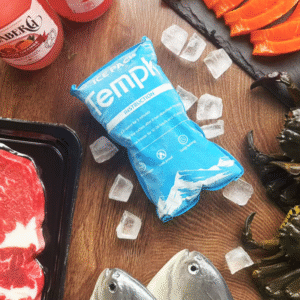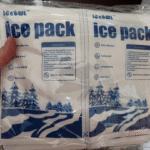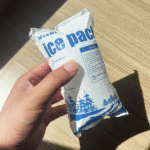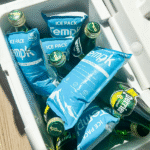Envio de itens perecíveis, como carne congelada, frutos do mar, and ice cream requires careful planning to ensure that they maintain their safety and quality during transit. Proper packaging and the correct amount of dry ice are essential in keeping these products frozen. Neste artigo, we will walk you through how to calculate the right amount of dry ice, provide guidelines for specific products, and offer tips on the best packaging practices.
-
Understand the general guidelines for calculating gelo seco needed for frozen goods
-
Aplicar product-specific ratios for frozen meat, frutos do mar, e sorvete
-
Aprender best practices for dry ice packaging to avoid thawing and spoilage
-
Explore the 2025 cold chain shipping trends like smart sensors and sustainable materials
-
Understand the regulatory and safety requirements when shipping dry ice
How Does Dry Ice Keep Products Frozen During Shipping?
Dry ice is an essential component for shipping perishable goods. Ao contrário do gelo regular, que derrete na água, dry ice sublimates directly into carbon dioxide gas at a temperature of -109.3°F (-78.5°C). This extreme cold helps maintain frozen meat, frutos do mar, and ice cream at their required temperatures throughout the shipping process.
The unique property of dry ice—sublimation—ensures that it can maintain a dry and consistent cooling environment, but it also means that it gradually disappears as it changes into gas. Understanding this process is critical when estimating how much dry ice is needed for different shipping durations and environmental conditions.
Dica: Dry ice is effective for longer shipping times, but you’ll need more if shipping in hot climates or during prolonged transit.
What Factors Affect the Amount of Dry Ice Needed?
The quantity of dry ice required can vary based on several key factors:
-
Duração do envio: Quanto maior o tempo de envio, the more dry ice you’ll need. Tipicamente, dry ice sublimates at a rate of 5-10 libras a cada 24 hours under average conditions.
-
Temperatura ambiente: Dry ice sublimates faster in hot climates. Portanto, it’s important to adjust your dry ice amount for higher temperatures.
-
Tamanho e isolamento do pacote: Larger packages or those with poor insulation will require more dry ice to maintain the desired temperature.
-
Tipo de produto: Different products require different amounts of dry ice to stay frozen. Por exemplo, ice cream requires lower temperatures than meat or seafood, thus requiring more dry ice.
| Fator | Impact on Dry Ice Needs |
|---|---|
| Duração do envio | Remessas mais longas precisam de mais gelo seco |
| Temperatura ambiente | Hot weather speeds up sublimation, exigindo mais gelo seco |
| Tamanho do pacote | Larger packages need more dry ice |
| Tipo de produto | Ice cream needs more dry ice due to stricter temperature requirements |
Best Practices for Shipping Frozen Goods
-
Use embalagem isolada: Opt for insulated containers such as Styrofoam or thermal blankets to slow down the sublimation of dry ice and maintain cold temperatures for longer durations.
-
Properly Layer Packaging: Place the dry ice at the bottom and top of the box, with the product in the middle. This ensures even cooling.
-
Recipientes Ventilados: Avoid sealing the container airtight, as dry ice needs to sublimate into gas. Leaving small ventilation holes will allow the gas to escape safely.
How Much Dry Ice Do I Need for Different Products?
The quantity of dry ice depends on the type of product and the shipping duration. Aqui está uma diretriz geral:
For Frozen Meat:
-
Frozen Meat: Para todo 5 libras de carne congelada, usar cerca de 2.5 para 3 lbs of dry ice for 24-hour shipping.
-
Por exemplo, um 10 lb shipment of meat requires 5-6 lbs of dry ice for a 24-hour delivery.
-
For longer shipping times, adicionar 1-2 lbs of dry ice for every 10 lbs of meat per additional 24 horas.
-
For Seafood:
-
Frutos do mar: Seafood is highly perishable and requires approximately 3 libras de gelo seco por 5 lbs of seafood for a 24-hour shipping period.
-
Por exemplo, um 10 lb shipment of seafood needs about 6 lbs of dry ice for 24 horas.
-
For 48-hour transit, usar 8 lbs of dry ice for the same 10 lb shipment.
-
For Ice Cream:
-
Sorvete: Ice cream needs to stay at a temperature of -20°F (-28.8°C). Você precisará 3 para 4 libras de gelo seco por 5 lbs of ice cream for 24-hour shipping.
-
Por exemplo, um 10 lb shipment of ice cream requires 6-8 lbs of dry ice for 24 horas.
-
Para remessas em 48 horas, increase the dry ice to 8-10 libras.
-
| Tipo de produto | Gelo seco necessário (por 5 libras) | 24-hour Shipping | 48-hour Shipping |
|---|---|---|---|
| Frozen Meat | 2.5-3 libras | 5-6 libras | 7-9 libras |
| Frutos do mar | 3 libras | 6 libras | 8 libras |
| Sorvete | 3-4 libras | 6-8 libras | 8-10 libras |
How to Pack Frozen Items for Safe Shipping
Proper packing is key to keeping your frozen items safe. Here’s how you should pack frozen meat, frutos do mar, and ice cream to prevent thawing:
-
Select the Right Packaging: Use insulated boxes, refrigeradores de espuma, ou sacos selados a vácuo. You can also use thermal blankets for extra insulation.
-
Place Dry Ice Carefully: Place the dry ice at the bottom of the box, and ensure it doesn’t come into direct contact with the frozen items to avoid freezer burn.
-
Seal the Package Tightly: Ensure the box is sealed tightly, but leave space for ventilation to allow dry ice to sublimate properly.
-
Rotule o pacote corretamente: Rotule claramente o pacote com “Dry Ice Inside” and “Keep Frozen” to alert handlers of the special requirements.
2025 Cold Chain Shipping Trends
À medida que a logística da cadeia de frio evolui, new technologies and practices are shaping the future of frozen goods shipping:
Monitoramento de temperatura inteligente
2025 brings advanced smart sensors that provide real-time temperature tracking, allowing shippers to monitor the state of frozen goods throughout the transit. These sensors help ensure compliance and prevent thawing during shipment.
Embalagem sustentável
With growing sustainability concerns, biodegradable and reusable insulated packaging materials are becoming more common. This reduces the environmental footprint and helps lower shipping costs in the long run.
Increased Demand for Cold Chain Logistics
The demand for cold chain logistics is predicted to grow by 12% annually due to the rise in consumer demand for perishable goods like frozen food and pharmaceuticals.
Perguntas frequentes
How Much Dry Ice Do I Need for a 2-Day Shipment of Frozen Meat?
For a 2-day shipment of frozen meat, you typically need 5-6 libras de gelo seco por 10 libras de carne. Always consider the insulation and external temperature when calculating.
Can Dry Ice Touch Food Directly?
Não, dry ice should never touch food directly. It can cause freezer burn or texture damage. Always separate the dry ice using a barrier like cardboard or foam.
Conclusão
Shipping frozen goods requires precise calculations for the right amount of dry ice. Use the guidelines above to estimate how much dry ice you need for different products. Ensure your packages are well-insulated, properly packed, and clearly labeled for safe and efficient transport. By following these practices and staying compliant with regulations, you can guarantee that your frozen products will arrive at their destination in perfect condition.
Sobre Tempk
E tempk, we specialize in providing reliable cold chain logistics solutions for shipping frozen goods. Our insulated packaging products, including dry ice bags and coolers, ensure that your products stay frozen and meet all regulatory requirements. For more information or a custom solution, contact our team today.
























